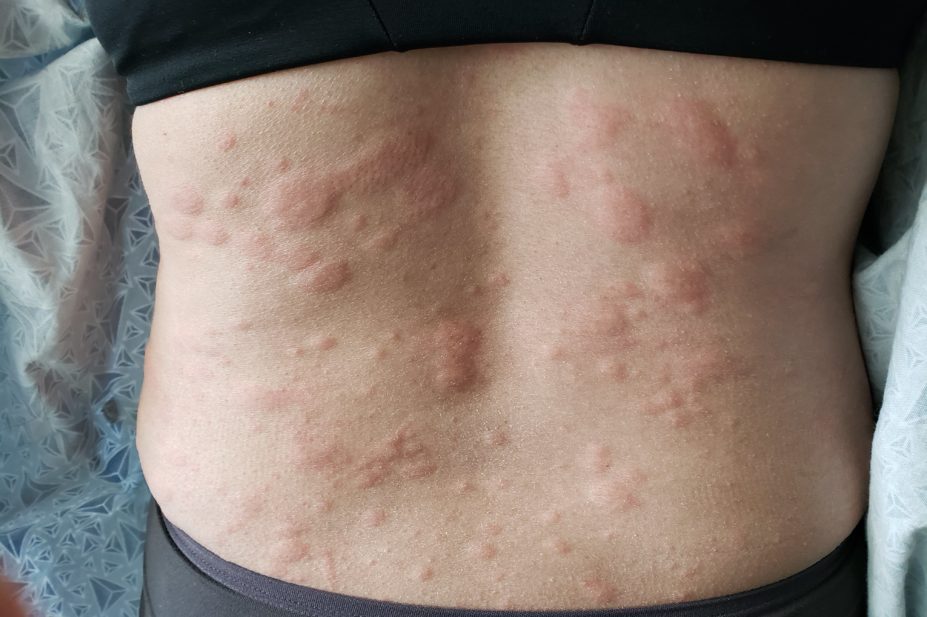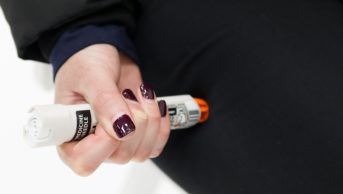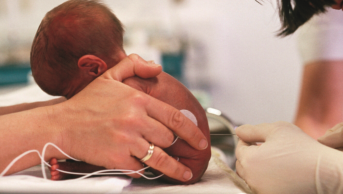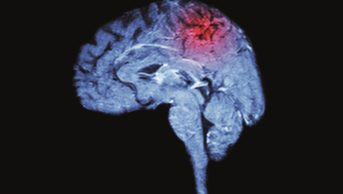
Shutterstock.com
Anaphylaxis is a life-threatening, generalised or systemic hypersensitivity reaction, involving the release of mediators from mast cells, basophils and recruited inflammatory cells, and is characterised by rapidly developing life-threatening airway and/or circulation problems with associated skin and mucosal changes[1],[2],[3]
. Often the result of an allergic response that can be immunologically mediated, non-immunologically mediated or idiopathic, it is estimated that around 1 in 1,333 people in England has experienced anaphylaxis at some point in their lives[4],[5]
. Although there are around 20 anaphylaxis deaths reported each year in the UK, this may be an under-estimate[4]
.
Pharmacists across all sectors will need to counsel patients who are diagnosed with anaphylaxis about the use of their medicine, as well as provide advice on trigger avoidance. For those who are not diagnosed, pharmacists can provide information about the tests that are undertaken to determine allergy status. This article will discuss the main symptoms and risk factors for anaphylaxis, and how it is diagnosed. For more on anaphylaxis treatment, see ‘Anaphylaxis: management’.
Mechanisms of allergic reaction
Immunoglobulin E-mediated response
Typically, anaphylaxis arises as an acute, generalised immunoglobulin E (IgE)-mediated immune reaction[6]
. The reaction requires priming (i.e. an initial exposure and sensitisation) by an allergen, followed by re-exposure (e.g. introduction into the body via ingestion, inhalation, parenterally or topically)[6]
. On first exposure, a susceptible person forms IgE antibodies specific to the antigen presented that attach to high-affinity Fc receptors on basophils and mast cells[3]
.
On subsequent exposure, binding of the antigen to the IgE antibodies leads to the cross-linking of two IgE molecules. This triggers the degranulation of mast cells and the release of chemical mediators (e.g. histamine, tryptase). These mediators subsequently lead to the clinical manifestation of anaphylaxis[3]
. IgE-mediated episodes of anaphylaxis tend to be more severe and have a more rapid onset than other non-IgE-mediated mechanisms[7]
.
In children, anaphylaxis is almost entirely owing to an IgE-mediated response[8]
.
Non-immunoglobulin E-mediated response
This response is poorly defined, both clinically and scientifically, and is thought to occur through mechanisms such as complement activation, kinin production or potentiation, and direct mediator release[6]
. It may occur on first exposure to an agent and does not require a period of sensitisation[6]
.
Signs and symptoms
The clinical manifestations of IgE-mediated and non-IgE-mediated anaphylaxis are identical[2]
. Symptoms can develop within minutes (e.g. through parenteral antigen exposure) or gradually over a few hours (e.g. through oral or topical exposure)[9]
.
Anaphylaxis is characterised by rapidly developing life-threatening airway and/or circulation problems, usually associated with skin and mucosal changes
[3]
. However, a number of other symptoms may be experienced, which are described in more detail below.
Skin
Around 80–90% of patients with anaphylaxis will have cutaneous features, such as urticaria (see Photoguide A), rash, pruritis (itching), flushing and/or angioedema (see Photoguide B)[10]
. All areas of the skin can be affected.
However, skin changes alone do not constitute anaphylaxis; they should alert pharmacists and healthcare professionals to the risk of anaphylaxis[6]
.

Anaphylaxis photoguide: symptoms, causes and diagnosis
Source: Shutterstock.com
A: urticaria; B: angioedema; C: cyanosis
Respiratory system
Around 70% of allergic reactions affect the respiratory tract[10]
. Patients may experience swelling of the mouth, throat or tongue, which can cause breathing and swallowing difficulties. Patients may also have a hoarse voice and stridor (a loud, harsh, high-pitched sound produced by turbulent airflow through a partially obstructed airway), or wheeze[6]
.
Hypoxia with an oxygen saturation of less than 92% and central cyanosis (blue skin or lips; see Photoguide C) indicates severe anaphylaxis and requires urgent treatment[9]
.
Cardiovascular system
Increased vascular permeability, vasodilation and myocardial dysfunction can result in hypotension and cardiovascular collapse[11]
. Adults are more likely to have cardiovascular symptoms than children[6]
.
Other manifestations
Light-headedness, confusion, anxiety, sweating, syncope (loss of consciousness) or coma may also occur
[3]
. Gastrointestinal effects, such as nausea, vomiting, abdominal cramps and diarrhoea with soiling, may also be associated with anaphylaxis; however, these are usually overshadowed by more immediately life-threatening symptoms (e.g. breathing difficulties)[6]
.
Causes
There are a range of causes of anaphylaxis, which can be grouped together. These are outlined with examples of common triggers in the Table[6]
. If a cause or trigger cannot be identified, it is described as idiopathic anaphylaxis
[3]
.
The following sections discuss some of the common causes in more detail.
| Table: Common causes of immunoglobulin E and non-immunoglobulin E-mediated anaphylaxis | ||
|---|---|---|
| Mechanism of allergic reaction* | Group | Examples |
| IgE-mediated | Drugs, chemicals and biological agents | Antivenoms, cephalosporins, chlorhexidine, ethylene oxide, formaldehyde, gamma globulin, insulin, muscle relaxants, penicillins, protamine, semen, sulphonamides, thiamine, vaccines |
| Foods | Eggs, fish, flour, fruits, milk, peanuts, shellfish, tree nuts, vegetables | |
| Venoms and insect saliva | Ants, bees, hornets, jellyfish, scorpions, snakes, ticks, wasps | |
| Other | Horse dander, hydatid cyst rupture, latex, pollen | |
| Non-IgE-mediated | Drugs and biological agents | Angiotensin-converting enzyme inhibitors, aspirin, N-acetylcysteine, nonsteroidal anti-inflammatory drugs, opiates, radiocontrast media, vancomycin |
| Food additives | Metabisulphite, tartrazine | |
| Physical factors | Cold, exercise, heat | |
| *If a cause or trigger cannot be found, it is described as idiopathic anaphylaxis. | ||
| Source: Oxford University Press[6] | ||
Foods
Between one-third and half of anaphylaxis cases that present to emergency departments are caused by foods, with the highest incidence of these cases occurring in young children[7]
. Food triggers include fruits, nuts, eggs and fish, with peanuts being the most common cause (see Table)[6]
.
Ingestion of the allergen is the most common route of exposure; however, aerosolised food proteins may also induce reactions, especially cow’s milk and fish. For some patients, even just handling the food can trigger a severe reaction[2]
.
Medicines
Some medicines can cause anaphylaxis in a small number of people, with penicillin being the most common cause. Serious reactions to penicillin occur around twice as frequently following intramuscular or intravenous administration compared with oral administration[12]
. However, it is necessary to correctly determine if a patient has a true allergy, as those who are falsely labelled as having a penicillin allergy risk being treated with alternative antibiotics (e.g. broad-spectrum, non-penicillin antibiotics) that have higher incidence of antibiotic resistance and poorer health outcomes[13]
. For more information on identifying penicillin allergy see ‘Accurately diagnosing antibiotic allergies’. In addition, allergic cross-reactivity to cephalosporins (typically first-generation cephalosporins) has been documented in under 4% of cases of drug-induced anaphylaxis[6]
.
Aspirin and nonsteroidal anti-inflammatory drugs (NSAIDs) can also cause drug-induced anaphylaxis, as well as anaesthesia[6]
. The incidence of anaesthesia-related anaphylaxis ranges from 1:10,000 to 1:20,000 cases, with 4–10% of reported reactions being fatal[6]
.
Insect stings
Reactions to insect stings of the order hymenoptera (i.e. wasps, bees and ants) occur in up to 3% of the UK population[6]
.
Latex
Reactions follow direct contact, parenteral contamination or aerosol transmission[6]
. Healthcare, hair, beauty, catering and motor industry workers are more likely to have a latex allergy[14]
.
Exercise
Anaphylaxis can occur with physical activity; however, up to 50% of cases are associated with prior ingestion of food or either aspirin or an NSAID. Food-associated, exercise-induced anaphylaxis occurs when a patient exercises within 2 to 4 hours of ingesting a specific food (e.g. wheat, celery, shellfish); however, it may occur after ingestion of any food[15]
. In these cases, it is thought that both cofactors (exercise and food) may be required for a reaction.
Risk factors
Patients who have previously experienced an episode of anaphylaxis are at increased risk of further occurrences[10]
.
Generally, parenteral antigens are more likely to trigger anaphylaxis than oral antigens.
Other risk factors include:
- Age – children are more likely to experience food-related anaphylaxis, whereas adults are more likely to experience anaphylaxis owing to antibiotics, radiocontrast media, anaesthesia and insect stings. Children and older people are at an increased risk of severe anaphylaxis;
- Gender – women have a higher risk of anaphylaxis owing to latex, aspirin, radiocontrast media and muscle relaxants, whereas men have a higher risk of anaphylaxis owing to insect venom;
- Atopic history – an atopic background could be a risk factor for exercise-induced and latex-induced anaphylaxis, but not drug-induced anaphylaxis;
- Comorbidities – people with asthma, cardiovascular disease, mastocytosis (abnormal accumulations of mast cells in the skin, bone marrow and internal organs) and substance misuse are at an increased risk of anaphylaxis[6],[10],[16],[17],[18],[19]
.
Diagnosis
Presentation of anaphylaxis is varied, and the signs and symptoms are not specific. The diagnosis of anaphylaxis is clinical because management cannot wait for laboratory confirmation of allergy[20]
.
Anaphylaxis is likely when all three of the following criteria are met:
- There is sudden onset and rapid progression of symptoms;
- There are life-threatening airway and/or breathing and/or circulation problems;
- There are skin and/or mucosal changes (flushing, urticaria, angioedema)[5]
.
Pharmacists and healthcare professionals should try to establish exposure to a known trigger; however, lack of obvious exposure does not exclude diagnosis.
Some conditions have overlapping symptoms with those of anaphylaxis and may lead to differential diagnosis — for example, severe asthma may also present with wheezing, coughing, and shortness of breath. However, associated itching, urticaria, angioedema, abdominal pain, or hypotension are more suggestive of anaphylaxis[12]
. Like anaphylaxis, sepsis can manifest with low diastolic blood pressure; however, associated skin changes are more likely to be petechiae (tiny purple, red, or brown spots on the skin) or purpuric (purple) in sepsis, compared with the erythema (patchy, or generalised, red rash) or urticaria (also called hives, nettle rash, wheals, or welts) associated with anaphylaxis[5]
. If the diagnosis is not clear, pharmacists should seek help and advice from senior clinicians.
If the patient is experiencing anaphylaxis, this is an emergency and an immediate intramuscular injection of adrenaline (epinephrine) into the middle of the outer thigh is required. Anaphylaxis is life-threatening; therefore, if suspected, call 999 and stop the suspected causative agent immediately[14]
. More information on emergency management in pharmacy settings, including adrenaline administration and dosing, can be found here.
In cases where a patient experiences an acute allergic reaction, pharmacists and healthcare professionals should refer them to an allergy clinic[4],[5]
. Here, testing for the precipitating allergen can be undertaken (see below) and the necessary steps taken, following the results, to ensure allergen avoidance and reduce the risk of recurrence[3]
.
Skin prick test
A drop of liquid containing the suspected allergen is dropped onto the forearm. The skin under the drop is then pricked. A positive result is when a wheal (a raised, red bump) greater than 3mm in diameter and larger than the negative control (using saline) appears within 15 to 20 minutes[20]
.
In vitro test
This type of test measures allergen-specific-IgE. It is less sensitive than skin testing and depends on clinical correlation, and the availability of specific assays[6]
.
The evolving Basophil Activation Test can potentially reproduce the immediate-type allergic reaction in the test tube without any risk to the patient[21]
.
Challenge test
Positive skin and in vitro IgE tests do not confirm the clinical relevance of the sensitisation; clinical history and challenge tests are usually required to make a formal diagnosis[3]
. A challenge test involves ‘challenging’ the patient with increasing amounts of the allergen, usually via the oral route. Although this is the best method of confirming diagnosis of allergy, it is not without risk and requires access to experienced staff in a safe medical environment[3]
.
Blood test
Tryptase, an enzyme realised from mast cells during an immune response, can be measured to differentiate IgE- from non-IgE drug-induced reactions. Serum tryptase levels are normally undetectable (<1nanogram/mL) in healthy individuals who have not had anaphylaxis in the preceding hours. Acute elevation of serum tryptase indicates degranulation of mast cells that can occur owing to an IgE-mediated mechanism (e.g. penicillin allergy) or may result from direct degranulation of mast cells through non-IgE-mediated means (e.g. NSAIDs or opiate allergy). Serum or plasma for tryptase should be obtained as soon as possible after emergency treatment has begun and a second sample ideally taken within 1 to 2 hours (but no later than 4 hours) from the onset of symptoms[4]
. To determine the baseline level of tryptase, an additional sample should be collected at least 24 hours after all symptoms have resolved.
Commercial allergy tests
Commercial allergy testing kits, such as hair analysis, kinesiology and vegatests, are not recommended. There is little scientific evidence to support their use and there are concerns that patients may be misled by results that could be false[20]
.
Useful resources
- The Anaphylaxis Campaign. Available at: www.anaphylaxis.org.uk
- Allergy UK. Available at: www.allergyuk.org
- Latex Allergy Support Group. Available at: www.lasg.org.uk
References
[1] Lieberman P, Nicklas RA, Randolph C et al. Anaphylaxis: a practice parameter update 2015. Ann Allergy Asthma Immunol 2015;115(5):341–84. doi: 10.1016/j.anai.2015.07.019
[2] Kumar PJ & Clark M (ed.). Kumar and Clark’s Clinical Medicine, eighth edn., Saunders (W.B.) Co Ltd: United States; 2012. p. 73.
[3] BMJ Best practice. Anaphlyaxis guideline. 2020. Available at: https://bestpractice.bmj.com/topics/en-gb/501 (accessed July 2020)
[4] National Institute for Health and Care Excellence. Anaphylaxis: assessment and referral after emergency treatment. Clinical guideline [CG134]. 2011. Available at: https://www.nice.org.uk/guidance/cg134 (accessed July 2020)
[5] Tse Y & Rylance G. Emergency management of anaphylaxis in children and young people: new guidance from the Resuscitation Council (UK). Arch Dis Child Educ Pract Ed 2009;94(4):97–101. doi: 10.1136/adc.2007.120378
[6] Warrell DA & Cox TM. Oxford Textbook of Medicine, fifth edn., Oxford: Oxford University Press; 2010. p. 3106–3114
[7] National Institute for Health and Care Excellence. Food allergy in under 19s: assessment and diagnosis. Clinical guideline [CG116]. 2011. Available at: https://www.nice.org.uk/guidance/cg116 (accessed July 2020)
[8] Holloway E & Sharma N. Anaphylaxis in children - help them reduce their fear and gain control. Pharm J. 2012. Available at: https://www.pharmaceutical-journal.com/cpd-and-learning/learning-article/anaphylaxis-in-children-help-them-reduce-their-fear-and-gain-control/11093703.article (accessed July 2020)
[9] Mali S & Jambure R. Anaphylaxis management: current concepts. Anesth Essays Res 2012;6(2):115–123. doi: 10.4103/0259-1162.108284
[10] LoVerde D, Iweala OI, Eginli A & Krishnaswamy G. Anaphylaxis. Chest 2018;153(2):528–543. doi: 10.1016/j.chest.2017.07.033
[11] Kounis NG, Cervellin G, Koniari I et al. Anaphylactic cardiovascular collapse and Kounis syndrome: systemic vasodilation or coronary vasoconstriction? Ann Transl Med 2018;6(17):332. doi:10.21037/atm.2018.09.05
[12] Simons FE, Ardusso LR, Bilò MB et al. 2012 Update: World Allergy Organization Guidelines for the assessment and management of anaphylaxis. Curr Opin Allergy Clin Immunol 2012;12(4):389–99. doi: 10.1097/ACI.0b013e328355b7e4
[13] Robinson J. Dangerous labels: incorrect penicillin allergies fuel antibiotic resistance. Pharm J 2020;304(7938):382–385. doi: 10.1211/PJ.2020.20207807
[14] NHS inform. Anaphylaxis. 2020. Available at: https://www.nhsinform.scot/illnesses-and-conditions/immune-system/anaphylaxis#causes-of-anaphylaxis (accessed July 2020)
[15] Sampson HA. Anaphylaxis and emergency treatment. Pediatrics 2003;111(6):1601–1608. PMID: 12777599
[16] Chen W, Mempel M, Schober W et al. Gender difference, sex hormones, and immediate type hypersensitivity reactions. Allergy 2008;63(11):1418–1427. doi: 10.1111/j.1398-9995.2008.01880.x
[17] Iribarren C, Tolstykh IV, Miller MK & Eisner MD. Asthma and the prospective risk of anaphylactic shock and other allergy diagnoses in a large integrated health care delivery system. Ann Allergy Asthma Immunol 2010;104(5):371–377. doi: 10.1016/j.anai.2010.03.004
[18] Worm M, Edenharter G, RuÃŽff F et al. Symptom profile and risk factors of anaphylaxis in Central Europe. Allergy 2012;67(5):691–698. doi: 10.1111/j.1398-9995.2012.02795.x
[19] Brockow K & Ring J. Update on diagnosis and treatment of mastocytosis. Curr Allergy Asthma Rep 2011;11:292–299. doi: 10.1007/s11882-011-0199-2
[20] The Anaphylaxis Campaign. Allergy Testing: the facts. 2018. Available at: https://www.anaphylaxis.org.uk/knowledgebase/allergy-testing-the-facts/ (accessed July 2020)
[21] Hemmings O, Kwok M, McKendry R & Santos AF. Basophil activation test: old and new applications in allergy. Curr Allergy Asthma Rep 2018;18(12):77. doi:10.1007/s11882-018-0831-5


